The most interesting thing I did, at least in terms of "I don't think most foreign baseball fans EVER do this", was that I went to Hitotsubashi Hall in Jimbocho on Saturday afternoon to watch the bracket drawings for the Intercity Baseball Tournament, which is the big amateur league tournament that takes place every year towards the end of summer.
It's basically like Koshien for adults -- all over the country, there are regional tournaments for a few months in the spring and summer to decide which teams will represent the various regions of Japan. Most of the teams will be company teams, which are basically "extracurricular" arms of big corporations such as Toshiba, Honda, Toyota, Mitsubishi, JR, JFE, etc. Some will be club teams. The format is single-elimination, 32 teams at the start, and is played for 10 days at the Tokyo Dome. Most of the teams, especially the ones from the Tokyo area, will bring thousands of supporters (read: company employees) and marching bands and cheerleaders, and half of the fun of going to the game is to see the cheering sections. I've posted about a few of these games in the past.
Anyway, did you ever wonder how they decided the bracket and schedule for the 32 teams that play each other? Me neither, but in the course of two hours of the assembly, I discovered way more than anyone would ever need or want to know about the process. Come along with me as I enlighten you with photos and videos from my journey through Lots Of Brackets.
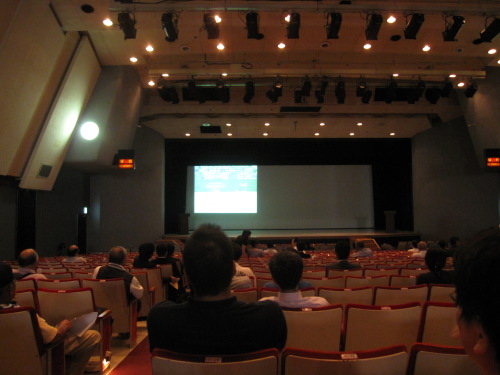
I think the auditorium seated around 300-400 people. Offhand I'd say it was about half baseball fans, one-quarter team representatives, and one-quarter media, judging by the suits and cameras and whatnot.
I went to this with one of my college baseball friends. Her pet player at Meiji was a kid named Takuma Kobayashi, who graduated last year and now plays for JR Hokkaido. The main reason she wanted to go to this bracket drawing was to know as soon as possible whether she'd be able to come see him play or not.
Before the assembly started, they were showing videos from past Intercity tournaments. It was funny realizing that hey, I actually remember watching a bunch of these games at a few points, as well as seeing some players in older videos like "OMG that's Yohei Kaneko!" and so on.
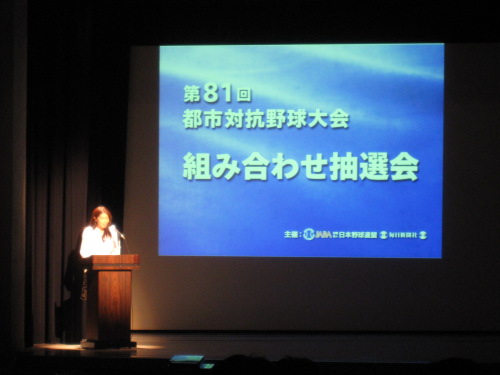
Finally, at 2pm, the assembly started.
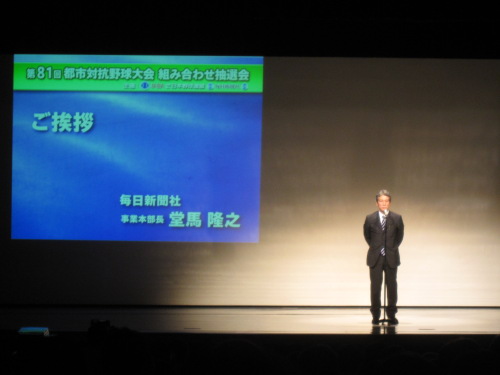
A guy from the Mainichi newspaper made an opening speech. I zoned out for most of it. I just don't speak Corporate very well.

They had an outline of how the procedures would go for the day.
Basically, first they would split into even-numbered and odd-numbered teams for the bracketing by regions, so nearby teams couldn't play each other. I believe odd-numbered teams were supposed to be the away teams for the matches.
Then they would split out teams that were from the same company group (ie, Mitsubishi, JR, NTT, etc)
Then they'd announce the special seeded teams.
Then choose brackets for odd teams -- and then choose brackets for even teams.
Finally, they would choose the order for most of the games to be played in (some were determined by seeds, but they didn't explain that until later).

A list of the different groups of regional representatives that would be called up. I believe these three guys were from Tokai, South Kanto, and Tokyo.
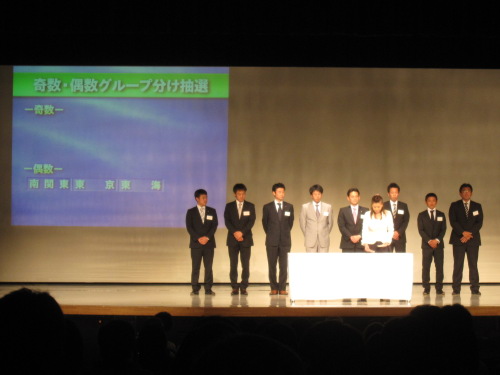
...and all of them chose to be even-numbered games! These are the huge group of guys representing Tohoku, North Kanto, Kanagawa, North Kansai (Kyoto Shiga Nara), Osaka, Wakayama, Hyogo, Chugoku, and Kyushu.
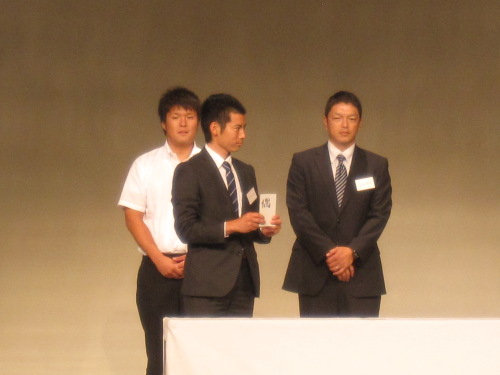
These three represented Hokkaido, Hokushinetsu, and Shikoku.
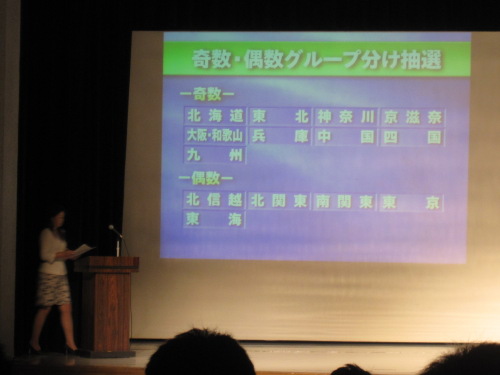
When the dust cleared, it was determined that this was the regional split for the odd and even games. How this worked out is actually beyond me, given the parity, but it did split into 16 and 16 somehow.

Next they explained how teams from the same company would all automatically be put in different blocks. How they managed to work this out is also beyond me (and since Mitsubishi had 5 teams, Mitsubishi Heavy Industries Nagoya and Kyushu Mitsubishi Motors actually are both in the A Block).
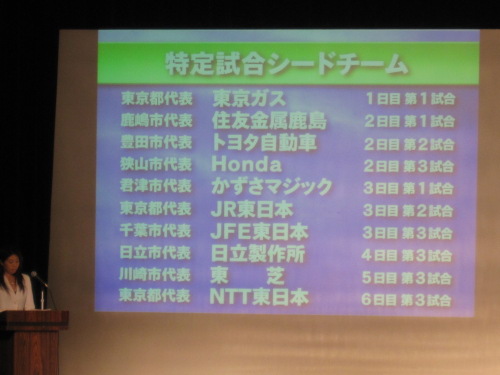
Next they announced the special seeded teams and which games they would play in. (The idea being that seeded teams don't have to play each other in the first round.) If you can't read, they are:
1-1 Tokyo Gas
2-1 Sumitomo Metals Kashima
2-2 Toyota
2-3 Honda
3-1 Kazusa Magic
3-2 JR Higashinihon
3-3 JFE Higashinihon
4-3 Hitachi Seisakusho
5-3 Toshiba
6-3 NTT Higashinihon
Incase it isn't obvious why they have these specific games, it's for the convenience of these teams to bring their fans and employees to the games outside of normal working hours, and thus draw the biggest audiences. The 1st day of the tournament is Friday August 27, so the first game is at 6:30pm then. The 2nd and 3rd days are weekend days, and then the 4-6 days are Monday-Wednesday, thus being seeded for the 3rd game of the day, which starts at 6pm, means they can make employees work a full day before coming to the Tokyo Dome to work "overtime" cheering for the company team. Ahem.
To be fair, as a normal working baseball fan, I also would of course prefer to go to those later games, although I probably won't be able to make many of the first round games anyway because I'm hoping to go to Shikoku for a weekend at the end of August.
Anyway, they called up guys after that to choose which blocks they were going to be in. There was a ridiculous fanfare they played for every team. Even though I took this video a LOT later in the drawing, it should give you an example of what this procedure was like:
Usually they'd have all the guys for a region come up at the same time and pick their group letters together, though this particular video was of Toyota, which for some reason came up by themselves.
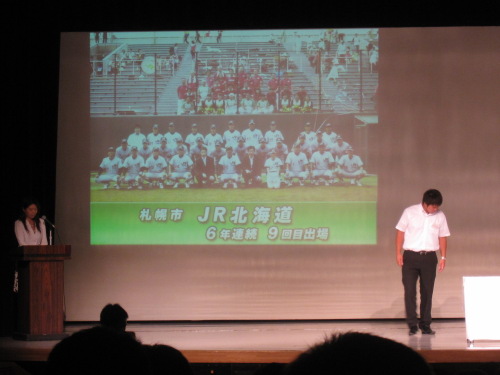
JR Hokkaido representative. (I'm guessing this guy is a player.)
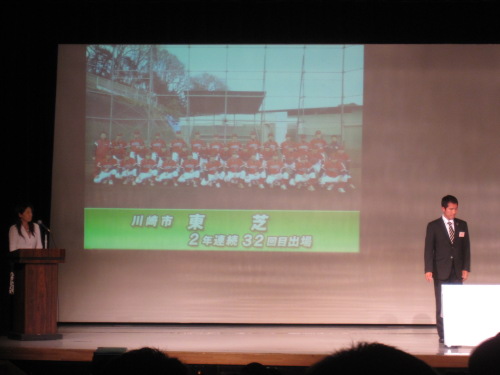
Toshiba representative.
The people in the region would choose to be either in the A, B, C, or D block. After they made their choice, they had to go sit down in a particular row of the seats in the back for their block.

So here is the whole stage, with the 16 guys sitting on the right getting ready to draw the ACTUAL games they'd be playing, block by block.
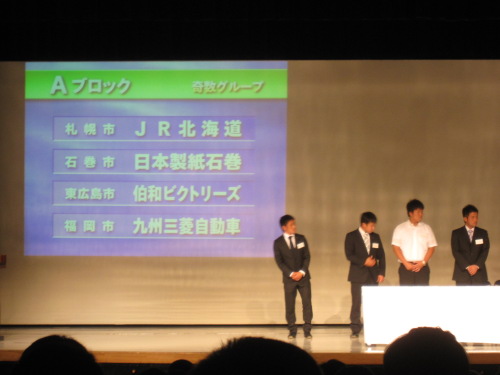
So here are the 4 dudes for the Odd-Numbered A Block teams, JR Hokkaido, Nippon Paper Ishinomaki, Hakuwa Victories, and Kyushu Mitsubishi Motors.
First they chose cards that would denote which order they would choose game slots in, 1, 2, 3, 4. Then they actually chose the game slots...
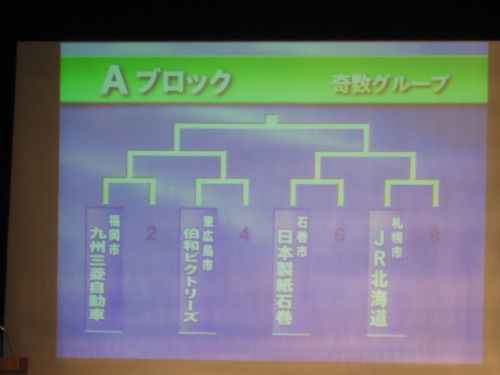
...and these were the results.
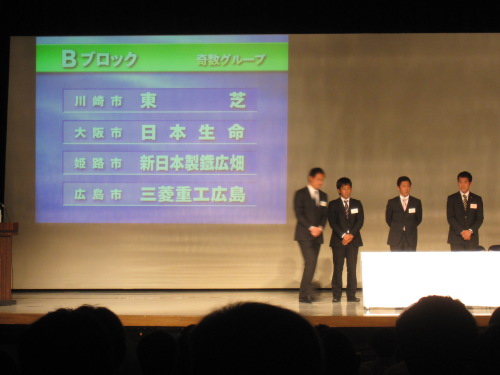
Repeat for the Odd B-Guys, Toshiba, Nihon Seimei, Shin-Nippon Seitetsu Hirobata and Mitsubishi Heavy Industries Hiroshima.
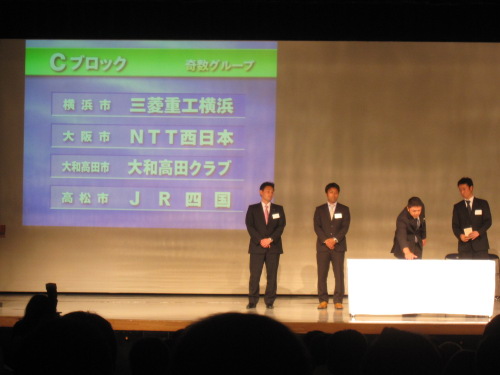
Odd C-Block: Mitsubishi Heavy Industries Yokohama, NTT Nishinihon, Yamato Takada Club, and JR Shikoku.
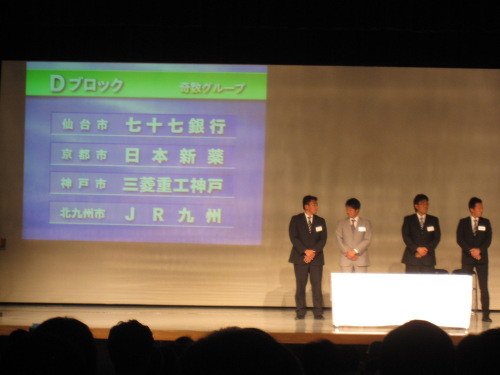
The Odd D-Block: 77 Bank, Nippon Shinyaku, Mitsubishi Heavy Industries Kobe, and JR Kyushu.

What it looked like when these first 16 guys had chosen their games.
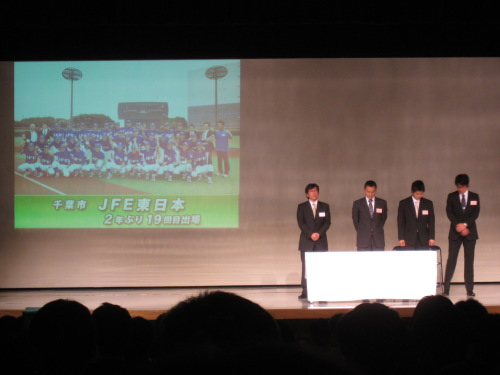
Minami-Kanto group comes up, finishing with JFE Higashinihon. (I took the shot of them with the team because I'm a fan of several of their players.)
So here is another video -- of the game choosing among the B-Block of the Even-Numbered Games:
B was JR Higashinihon, JFE Higashinihon, Toho Gas, and Tokai Rika. This was largely determined by many people to be a pretty tough bracket this year (kind of a tossup between B and D, if you ask me). As you can hear in the video, several people laugh when Tokai Rika draws Toshiba as their opponents, for example.
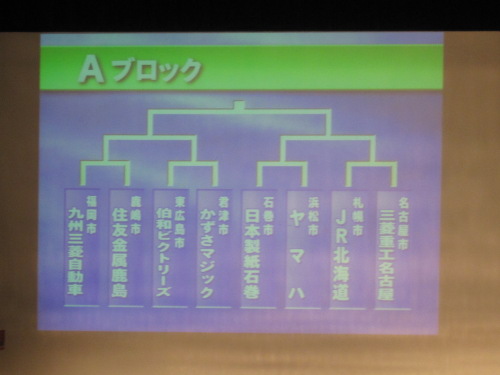
A-Block results with all of the games drawn.
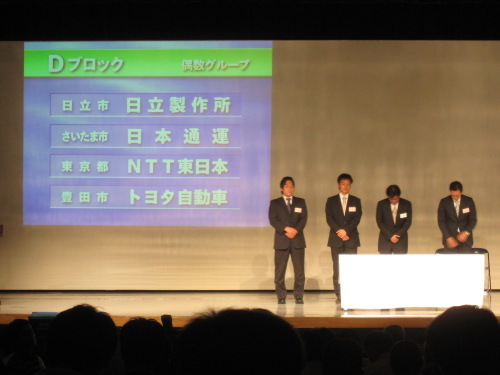
The Even D-Block guys get up to finish out the Hell Bracket.
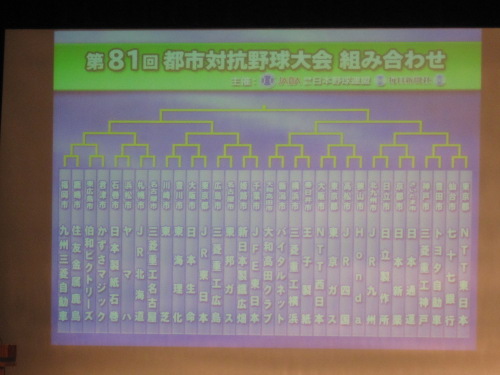
Here is what it looked like when all 32 teams had drawn their game slots.
You'd think this would be finished now, right? And they'd just proceed that the first game started at the left, and the schedule went onwards like that, right?
WRONG...
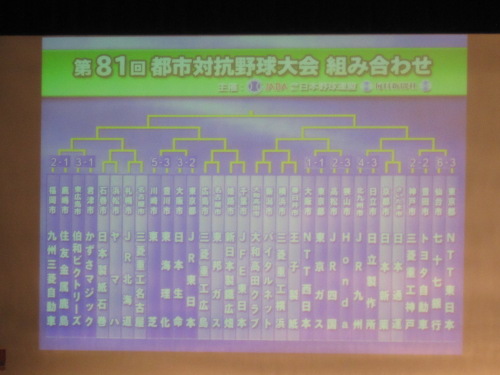
Remember, seeds were seeded to specific games. So first they filled those in at the top...
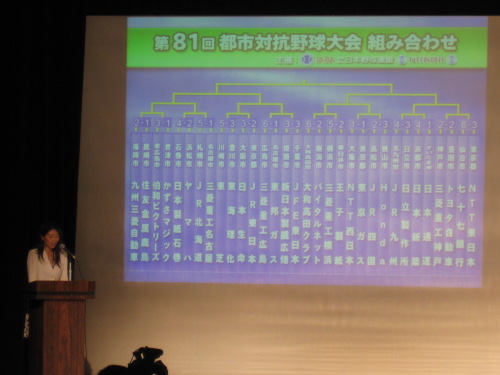
...and then they had people come up and choose the REST of their slots. So this is what the entire schedule looked like when it was done. Just because you are in a specific bracket doesn't mean you will be playing anywhere near the other teams in your bracket. Also, some teams have to play on 2 days of rest between their first two games, when others have a week. It's kind of crazy.
Several people left the hall at this point, once the full bracket was determined...
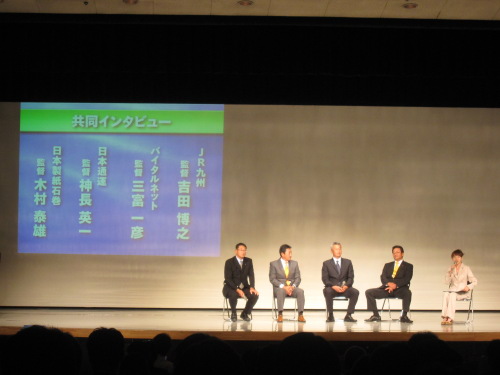
...but we stuck around to hear an interview they did with a few of the managers -- the guys from JR Kyushu, Vitalnet, Nippon Express, and Ishinomaki.
At pretty much exactly 4pm they said "Okay, that's all the time we have! Ceremony over! See you all at the Tokyo Dome next month!" and kicked us out of the room.
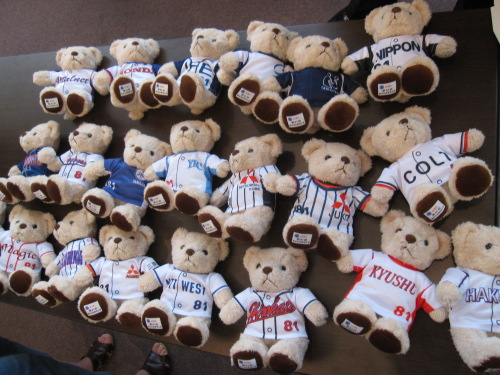
On the way out we saw these awesome bears they had made for every team, that they were giving to the team representatives. About 1/3 of them were gone by then, but there were still several adorable ones representing teams I want to see. Awwww.
And for the record, they also gave a present to people who attended the bracketing...
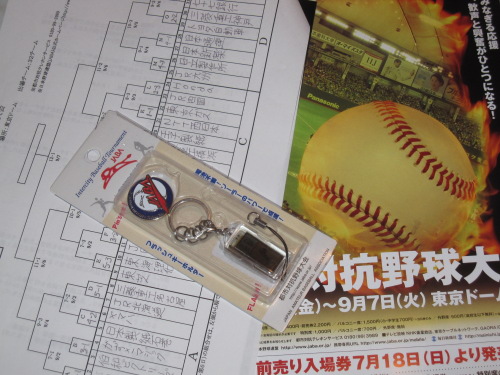
...a JABA pinbadge and solar-powered blinking keychain/cellstrap thingy. I don't know if I'll ever actually use mine, but it's still a kind of neat souvenir. (And yes, that is my hand-written bracket that I was making as they were drawing teams.)
There isn't a lot of info about the Toshitaikou out there in English, but here is the JABA site about it. I'll certainly be going to a bunch of the games, though that Sept 4-5 weekend is going to be TOUGH to choose what baseball to watch, dang.
Here is a list of on-loan players, ie, guys whose teams didn't make it into the tournament so they will be playing for some teams that did make it. To me the most notable is former Toyodai infielder Takuya Tsukuura, now playing for Sega Sammy, but in this tournament he'll be on JR Higashinihon's team.
Here is a PDF of the brackets (Japanese)
Or here, I'll just type it into English:
1-1 NTT Nishinihon @ Tokyo Gas
2-1 Kyushu Mitsubishi Motors @ Sumitomo Metals Kashima
2-2 Toyota @ Mitsubishi Heavy Industries Kobe
2-3 JR Shikoku @ Honda
3-1 Hakuwa Victories @ Kazusa Magic
3-2 JR Higashinihon @ Nihon Seimei
3-3 Shin-Nippon Seitetsu Hirobata @ JFE Higashinihon
4-1 Nippon Shinyaku @ Nippon Express
4-2 Nippon Paper Ishinomaki @ Yamaha
4-3 JR Kyushu @ Hitachi Seisakusho
5-1 JR Hokkaido @ Mitsubishi Heavy Industries Nagoya
5-2 Oji Paper @ Mitsubishi Heavy Industries Yokohama
5-3 Toshiba @ Tokai Rika
6-1 Mitsubishi Heavy Industries Hiroshima @ Toho Gas
6-2 Yamato Takada Club @ Vitalnet
6-3 77 Bank @ NTT Higashinihon
Day 1 is August 27th, Day 6 is September 1. Each day, Game 1 is at 10:30am, Game 2 at 2pm, Game 3 is at 6pm.
Should be a lot of fun. I'm hoping to go to most of Day 5, and then some of the later evening games during the week (work starts on September 1 for me again), and the weekend will depend on which teams make it. I really want to see Toshiba, Toyota, JFE Higashinihon, and JR Higashinihon... they all have former players I really liked in Tokyo Big 6, as do other teams. I also want to see Honda -- especially now that Hisayoshi Chono isn't on the team anymore, I can actually cheer for them without holding back. Yay!
BTW, I hope people find this kind of post actually interesting/informative. I sometimes have no clue if this kind of thing is even worth blogging about.
3 comments:
This is incredibly fascinating and the transparency of the process is really very cool. The Japanese are notoriously 'process oriented' (as opposed to Americans who are notoriously results-oriented as in 'we got the right results, who cares HOW it was done') and little things like this confirm this.
BTW, I am a LONG TIME reader, first time commentator. I post often on Andrew's 'Where Eagles Dare' blog.
Oh, yeah, I recognize your name.
Thanks for the comment -- that is a pretty spot-on observation. When I was at the assembly, I had a lot of trouble understanding what was going on at first (probably partially due to some unfamiliar vocabulary in the paper explaining it all), though everyone there seemed to know exactly what was happening and why it would all magically work out to split the teams up properly. But once I started seeing how things fell into place, when I went back and re-read the slides/notes, it was like "Oh! Duh! Of course you can do it that way." Like I needed results to understand the process, in a way. Though, if I would be here next year, I think I would be able to follow as it went along just fine, now that I know how it works...
Actually, after the Fighters moved to Sapporo they were my favorite team but became my second favorite team after the Rakuten Eagles were formed.
I recognize that without their initial stay in Tokyo it would be unlikely that you would be a huge fan, but man, I HATED the fact that they were such second fiddle to the Giants. All. But. Invisible.
The Fighters (in Tokyo) reminded a lot of Kintetsu and Orix when they were around: a fairly nameless, anonymous team with a small, albeit loyal following in the shadow of a Central League behemoth.
Now that Rakuten and Nippon Ham have their own regional identities, it has made them much, much more appealing as teams. What's amazing is that virtually every single Pacific League team has moved in the last 20 years or so (Softbank from Osaka to Fukuoka, Rakuten, Nippon Ham, Lotte from Kawasaki to Chiba and Seibu hasn't been in Saitama too long either). I think that there is finally some stability in the Pacific League and it shows in the attendance #'s.
Post a Comment